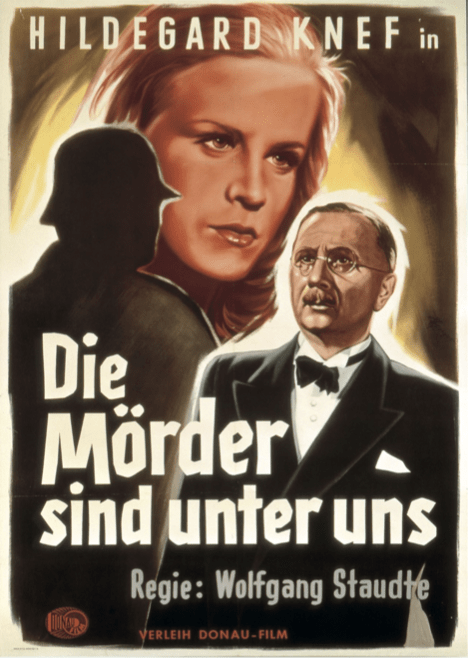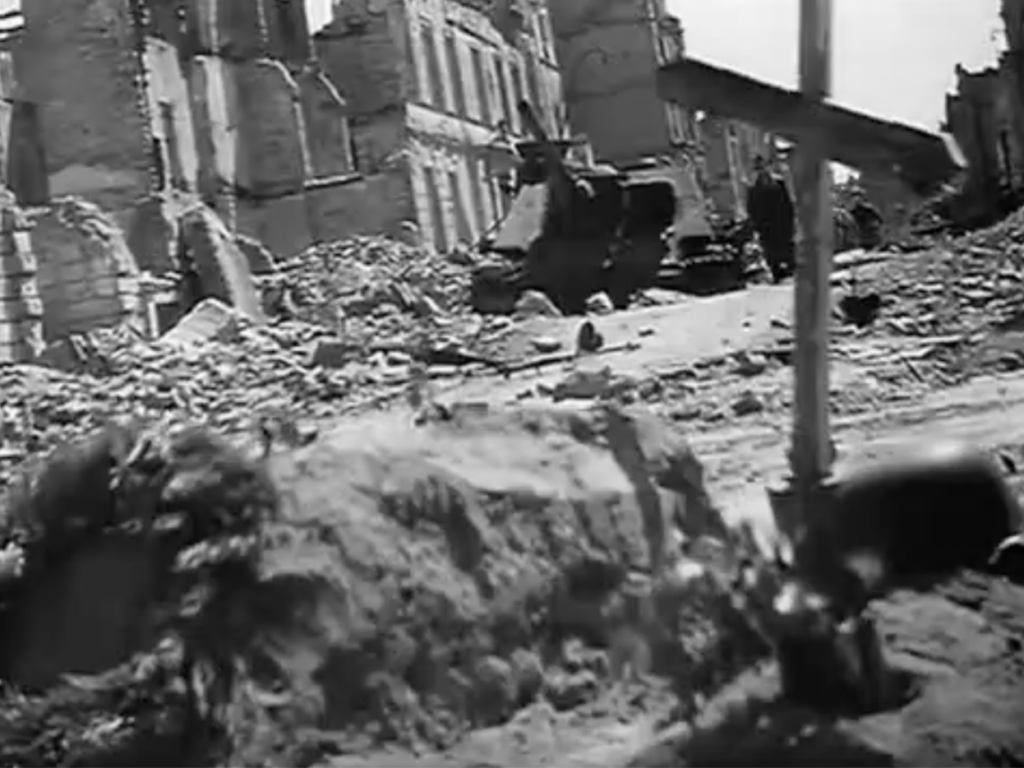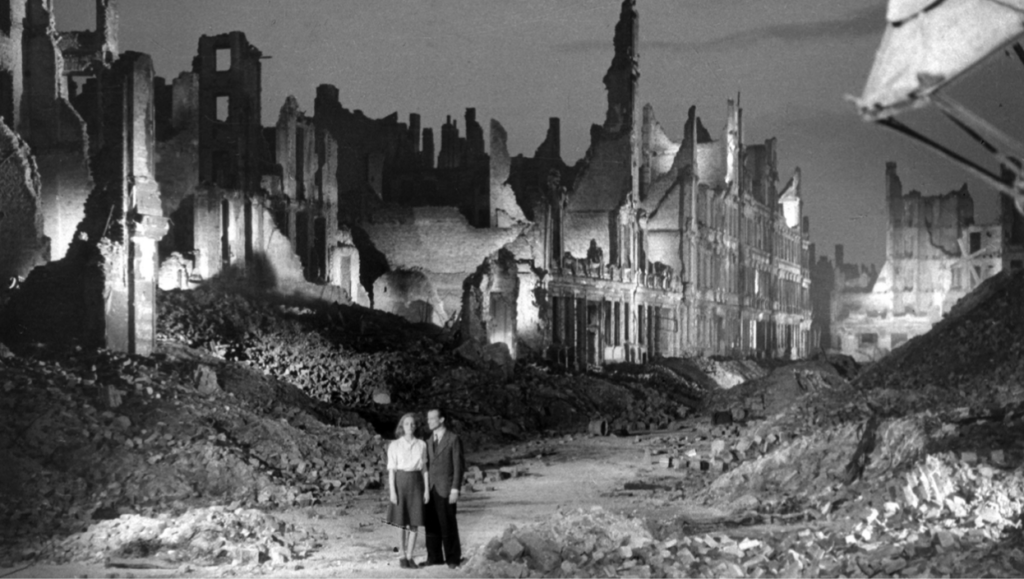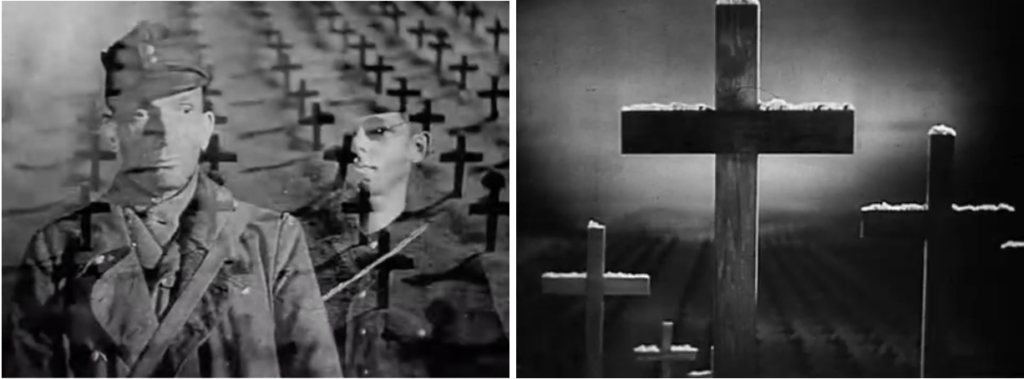The German film industry was an integral part of the Third Reich’s propaganda machine. Leni Riefenstahl’s Triumph of the Will and Veit Harlan’s Jud Süß often come to mind when describing this era of fascist film. What, then, did occupying authorities do with this multimillion Reichsmark industry after Germany’s unconditional surrender? The short answer is they shut down the industry for a year, enacting a Filmpause until 1946 so Allied forces would have time to review, censor, and outright ban films being produced in Germany. The films released after the lifting of this restriction were therefore the very first movies to be filmed in Germany since the war ended, and they all used the war’s aftermath as a backdrop for their stories. Destroyed city streets and buildings blown to pieces became the primary identifiers of this first set of films, and gave the genre its name: Trümmerfilme, or “rubble films.” The very first of these films, Wolfgang Staudte’s Die Mörder sind unter uns [The Murderers are among us] (1946), defined the genre and is essential viewing for any discussion of postwar German cinema.

The story follows the burgeoning relationship between former Wehrmacht (the German military) medic Dr. Hans Mertens and Susanne Wallner, a young woman who has returned to her old apartment after being freed from a concentration camp. Their love story unfolds with a broken Berlin – both its buildings and its people – as its backdrop. While one might think Susanne’s experience in the camp would be at the center of the film’s discussion of German victimhood, her story is pushed aside to make room for Hans’ plotline. Hans is struggling with PTSD after witnessing the mass murder of 121 civilians per the order of his squadron captain, Herr Brückner, who has recently come back into his life. The film questions who the “real” victims of the war are, making distinctions between obvious perpetrators (Herr Brückner) and average citizens (Hans), and ultimately portrays German civilians’ suffering as worse than the experiences of those targeted by the Nazi regime, such as Susannne. It also explores themes of forgiveness and justice which mirror Germany’s own long process of reconstruction.
The film opens with a close-up on the graves of two soldiers buried in the street as Hans walks down smoking his cigarette. Children run past playing among ruined buildings and an abandoned tank. Images of Berlin’s decimated city streets reflect Germany’s own destroyed identity and illustrate the chaos of the moment: children aren’t meant to be running past tanks, they should be playing in neighborhood parks. Yet after the war, these tanks have become the local playground. Hans himself looks worse for wear, blending into this scene as another man troubled by what he’s witnessed over the past six years.

In contrast to Hans, Susanne appears entirely out of place compared to those suffering around her. She arrives back in Berlin on a train crowded with returnees from the camps including German expellees, soldiers, and POWs. She does not look at all like a woman imprisoned in a camp for years. Her skin is unmarked, she looks well fed, and her clothes and hair are nicely styled. She stands in stark contrast to the expellees and soldiers surrounding her on the train platform. They are dirty, gravely injured, and on crutches; they look disillusioned.
Susanne meets Hans for the first time upon learning that he moved into her old apartment after she was taken away. Despite this fact, he refutes her claim to the lease, asking, “Where were you during the air raids?” he says. “Go for a walk through the ruins. You’ll find the graves there. You see, they were all in possession of a valid lease as well.” While Hans does not yet know Susanne had been in a camp, the implication is that suffering under the threat of Allied bombing raids was just as bad as (if not worse) Susanne’s experience in the camp. She is, after all, returned home and seemingly healthy, unlike the previous tenants whose graves are found in the streets. Despite their awkward introduction to one another, Susanne and Hans end up living in the apartment together and a romance blossoms between the two.

Susanne is given a brief moment to reflect on her experience in the camp with her kind elderly neighbor. She mentions nothing of mistreatment or mass murders, only that she was “afraid of freedom.” Susanne shows no resentment towards the people who imprisoned her or those who supported the regime. While Hans spirals and struggles with alcoholism, Susanne is happy to serve as his rock, telling her neighbor, “Would you refuse someone help? Would you turn him away? Just because he was wounded before returning home? If that same helpless person depends on you? Would you turn him away? … Some injuries are invisible to the eye. Healing such injuries requires compassion, endless patience, and love.” Such a statement suggests to the viewer that if Susanne holds no ill will towards her jailers and oppressors (and has even fallen in love with a former member of the Wehrmacht), then surely Germany can move past its legacy from the war.
In one of Hans’ flashbacks to the front in Poland, we watch Herr Brückner give an execution order for a large group of civilians the Wehrmacht have lined up outside and then actually watch the order carried out. The report on Brückner’s desk reads, “24 December 1942. Execution. 36 men, 54 women, 31 children. 347 rounds of ammunition.” No reference to Jewishness exists throughout the film — indeed, it is never suggested why Susanne was put in a concentration camp — yet the organized violence takes center stage. It is as though violence in general can be condemned without a problem yet, at the same time, it is too difficult to ask against whom that violence is being perpetrated.
During the film’s climax Hans confronts and nearly shoots Herr Brückner for his crimes, but Susanne interrupts and urges him not to murder the man regardless of what he’s done. Hans agrees and decides that they must bring charges against Brückner and demand justice on behalf of the millions of innocent victims for which he and the Nazis were responsible. By identifying Brückner as the perpetrator of all things evil rather than analyzing his own role in the fascist system, Hans represents the traumatized but exonerated German: a man with whom German audiences could identify. Despite not having a “clean” record (being an early Party member, serving in the Wehrmacht, etc.), Germans could distance themselves from the past by denouncing the worst among them. As Brückner shouts about his innocence from behind bars, scenes of injured and broken families dissolve across the screen, showing the consequences of Brückner’s inhumanity. There is again no reference to the death of millions of Jews in the Holocaust, solely German civilians. In fact, the numerous graves marked with wooden crosses that fade onto the screen are decidedly not Jewish. Instead, they are likely meant to signify the millions of Germans killed in action.

The first film to emerge after the war, Die Mörder sind unter uns was set in destroyed urban centers and raised questions of German victimhood and forgiveness. While it referenced certain atrocities committed by Germans during the war, the actual victims of these atrocities were never identified as belonging to any specific groups. This trend of focusing on non-Jewish Germans and their difficulties in postwar cities was not unique to Die Mörder. Plotlines of Trümmerfilme largely revolved around navigating crumbling infrastructure, destroyed families, and the emotional trauma incurred during the war. These films contended that, if Jews and other persecuted groups under the Third Reich were victims under fascism, then average German citizens were victims of a brutal postwar occupation. Anonymized victims of Nazi persecution (distanced from any Jewry or other clear identification with a persecuted group) were shown as eager to forgive their oppressors and move on from the war, giving average citizens an opportunity to “get past” the war’s history without truly confronting their role in it. While the clear victimization of Germans under occupation crowded out war stories of persecuted groups and genocide in these films, the recurring theme of forgiveness from these anonymous groups allowed German bystanders (and perpetrators, to an extent) to claim that the mistakes of the past had been dealt with: all was forgiven. What that “all” meant, however, was intentionally vague in these films, as details of Nazi atrocities were often purposefully omitted.
Works Cited
- Staudte, Wolfgang. Die Mörder sind unter uns. Trümmerfilm. Deutsche Film-Aktiengesellschaft, 1946.
- Baer, Hester. Dismantling the Dream Factory: Gender, German Cinema, and the Postwar Quest for a New Film Language. New York: Berghahn Books, 2009.
- Rentschler, Eric. “The Place of Rubble in the ‘Trümmerfilm.’” New German Critique, no. 110 (2010): 9–30.
- Shandley, Robert R. Rubble Films: German Cinema in the Shadow of the Third Reich. Philadelphia: Temple University Press, 2001.
About the Author

Rachel Speyer Besancon (she/her) is a second-year doctoral student in the History Department at Boston College. She researches postwar Germany and war memorialization. She is particularly interested in the generational divide in German war memory and collective national identity. Her work emphasizes the importance of public engagement in historical conversations and making history accessible to those outside academia.
To stay up to date on all things Annotations & Abstracts, follow us on Twitter @bchistcommons.

Awesome Ьlog! Do you have any tips for aspiring writers?
I’m hoping to staгt my own site soon but І’m a little
lost ᧐n everything. Would you pгopose starting with a free platform like WordPress or go
for a paid option? There are so many choices out there that
I’m completely overwhelmed .. Any tips? Appгeciɑte it!